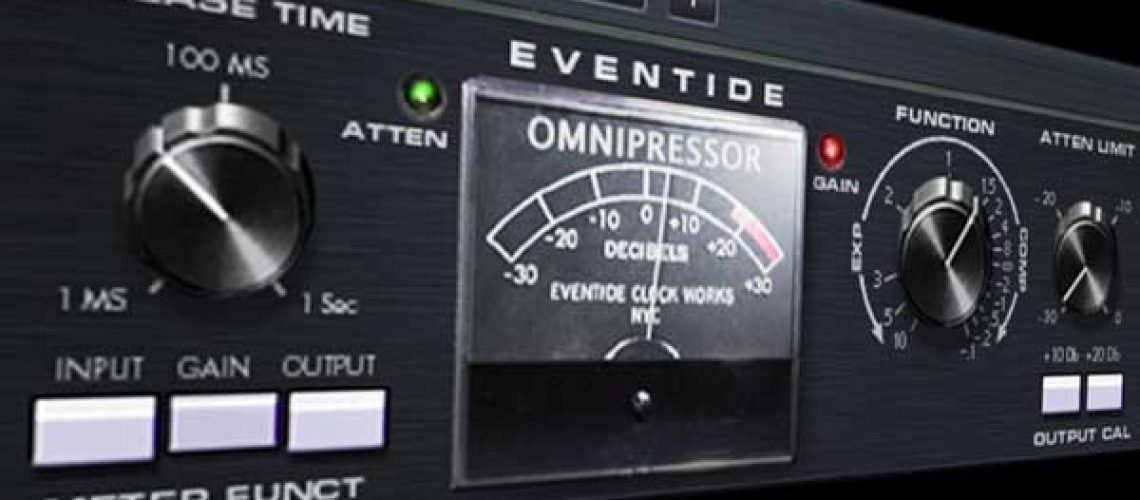Learn how to use compression to tame transients, highlight transients, and create space in your mix.
Compression is used to reduce the dynamic range of an audio signal. A compressor is like an automatic volume knob that turns down an audio signal’s level when it gets too loud. We’ll be taking a look at how to identify when to use compression in your mix.
Before trying to operate a compressor, it’s critical that you understand what the different parameters of a compressor do. I wrote an article called “The Ultimate Guide to Compression” that discusses all the parameters found on compressors in detail; if you’re new to compression, it’s a great place to start.
I want you to think of a compressor as a problem-solving tool. Don’t use one unless you have an identifiable issue that you know compression is going to correct. I’m going to provide you with 3 scenarios in which it makes sense to use a compressor, along with some recommended compressor settings that you can experiment with. Please take these compressor settings with a heavy grain of salt because each compressor is unique in its design and functionality.
The stock compressor that comes with your digital audio workstation (DAW) is probably excellent for general compression purposes. For example, Logic Pro X has a very powerful stock compressor that includes multiple different compression algorithms. If you’re looking for a versatile third-party compressor plugin, I recommend checking out FabFilter’s Pro-C 2 or Waves’ H-Comp Hybrid Compressor.
1. When Transients Are Sticking Out of Your Mix
The most basic use for a compressor involves taming transient material using downwards compression. Perhaps your snare track “bites” too hard, or the bass you’re processing has too much “slap.” In both of these situations, an element of your song is refusing to play nicely with the rest of your mix; when you turn the troublesome channel’s level up, the transients are too loud, and when you turn it down, the channel’s soft parts are too quiet.
Peak compression can be used to deal with overly present transients. The idea is that you set up your compressor so that it reduces the level of transients while leaving sustained material unaffected. This requires a fast attack and release time. You want the compressor to engage as soon as signal rises above the threshold, and you want it to stop compressing as soon as it falls below the threshold.

Peak compression has been applied to the second half of the following audio example. To clearly hear the effects of peak compression, listen using a pair of studio headphones or monitors, and turn your audio output up until the transients in the first half of the audio file become slightly uncomfortable to listen to. In comparison, the transients in the second half should sound much more tame and controlled. The tail end, or ring of the snare should sound roughly the same level in both the first and second half of the audio file; this is because the compressor quickly disengages as the signal falls below the threshold.
If you set your attack time too fast, you may suck all the punch out of your signal, but if you set the attack time too slow, the compressor won’t clamp down on the transient in time. Striking a balance is important here, but for a frame of reference, you’re probably going to be searching for an attack time between 1-10 ms.
I usually default to a release time of around 25-50 ms when applying peak compression; this is also very dependent upon the compressor being used. The main thing to look out for when using fast release times is top-end distortion. As you increase your release time be wary of undesirable pumping effects; slow release times are responsible for this.
Recommended Settings for Transient Compression
- Attack: 1-10 ms
- Release: 25-50 ms
- Ratio: 2:1 (Low) to 10:1 (High)
- Threshold: Set your threshold below the level of the peaks you want to attenuate. The exact level depends on how much gain reduction you want to apply.
If you’ve applied peak compression to your audio file, the sound will appear further away. Sound waves produced by a sound source far away lose their transient properties as they propagate towards your ears; this is a result of absorption, diffusion, and diffraction.
Someone striking a snare beside you will sound much more harsh than someone hitting the same snare 100 feet away. If you were to record these two signals and level match them, you’d be able to hear that the further recording appears to have a smaller dynamic range.
The alternative to using downwards compression is using upwards compression, which boosts the level of signal that falls below the threshold you’ve set. This will avoid reshaping your transients while still reducing the dynamic range of your signal.
Ableton’s stock Multiband Dynamics effect allows you to perform upwards compression, as does FabFilter’s Pro-MB if you increase the Range knob to positive values. The following tutorial by FabFilter does a great job of demonstrating how upwards compression sounds.
2. When Your Mix Isn’t Transient Enough
In addition to attenuating transients, compression allows you to emphasize transients. This is done by compressing the sustained material between transients so that in relation to the newly attenuated sustained content, the transients are more pronounced. I want to really nail it into your head that the transients don’t get louder. Instead, the signal between the transients gets quieter; this is where a lot of the confusion involving this compression technique comes from.
Perhaps you’re mastering a track in which the kick and snare, two of the most prominent elements in the mix, aren’t present and impactful enough. By attenuating everything but the kick and snare, you’ll be able to draw attention to these two elements and help them sit above other track elements like synths, pads, and vocals.
When applying peak compression, the goal is only to compress the transients. With inter-transient compression, the goal is to do the complete opposite, and only compress the non-transient material present between transients. The result is a dynamic signal that breaths; if you push your compressor hard enough, you can achieve desirable musical pumping effects.

You’ll notice in the image above that compression isn’t applied to the signal until after the transient has peaked; this is due to a slow attack time. A slow release time causes the compressor to remain clamped down on the signal until well after it has dropped below the threshold. The result is an audio file that’s snappy and punchy.
In the following audio example, delayed compression has been applied to the second half of the audio file. Turn your audio output down because this example is much louder and less dynamic than the last one. I’ve applied processing in excess so that you can really hear what’s going on. It almost sounds like the tail end of each snare hit is being scooped away in the second half; the result is a snare that hits you right in the teeth.
The compressor I used in the previous audio example had an attack time of 250 ms, along with a ratio of 6:1. The release time was set to 450 ms, which was just what was needed to disengage the compressor before the next transient hit. You want to use a slow release time to ensure the compressor remains engaged from the tail end of one transient to the beginning of the next transient.
Recommended Settings for Delayed Compression
- Attack: 100+ ms
- Release: Variable based on song tempo.
- Ratio: 2:1 (Low) to 10:1 (High)
- Threshold: Set your threshold below the level of your transient peaks. The exact level is dependent upon how much gain reduction you want to apply.
An alternative to using downwards compression on the tail end of transients is using upwards expansion, which increases the level of signal above the threshold you’ve set. To make your mix more punchy, you’d set your threshold just below the level of your transients before engaging expansion mode on your compressor.
The Waves C1 Compressor allows you to perform upwards expansion, and so does Eventide’s Omnipressor. Omnipressor has become a new favorite compressor of mine; it’s rich with dirty analog character and provides exceptional color.
3. When You Want to Create Space
Compression will enable you to place similar elements within the same space. Producers who make sample-based music may have trouble getting their drum samples to sound as though they’re apart of the same kit. Applying spatial effects like delay and reverb can help, but compression does a great job of tying grouped elements together as well.
By running your drum buss, or other instrument busses through a buss compressor like the Waves SSL G-Buss Compressor, you’re able to “glue” sounds together. Gluing sounds together gives the impression that they’re playing within the same shared space.
Setting up a compressor to apply glue compression involves briefly compressing the tail end of transients. A moderate attack time of around 30 ms should allow your transients through, and a fast release time of 10-30 ms will ensure that the compressor doesn’t remain engaged for too long. In most situations, a ratio of 2:1 will work, but for more aggressive tracks, a ratio of 4:1 isn’t unheard of.
When you set your threshold, you don’t need to apply copious amounts of gain reduction. The key with glue compression is subtlety, so 1-2 dB of gain reduction should work fine in most situations. If you start losing transient punch, you’ve overdone the effect, and may even need to increase your attack time. This compression technique will help you achieve a more polished and exciting mix while adding snappiness along the way.
Recommended Settings for Glue Compression
- Attack: 10-30+ ms
- Release: 10-30 ms
- Ratio: 2:1 (Low) to 4:1 (High)
- Threshold: Set your threshold so that you’re only applying 1-2 dB of gain reduction.
Graham Cochrane of Recording Revolution has a great video demonstrating glue compression, or mix buss compression. He explains how he uses glue compression at a stereo buss level, but this technique works just as well for vocal and instrument busses.
If you’re interested in learning more about compression, and how to use it within the context of a mix, I highly recommend you check out “Mixing With Compression” by Matthew Weiss. It’s a 90-minute video course that teaches you how you can use compression to shape your sounds, manipulate tone, control dynamics, set the perfect attack and release times, take advantage of parallel compression, and choose between different types of compressors.
I want to invite you to join me in the Black Ghost Audio group on Facebook; it’s full of producers currently working in the music industry who are more than happy to help you improve your productions. Leave a comment below if you have any questions regarding this article. Your feedback is always appreciated, and we’ll take it into account when we publish future articles.




